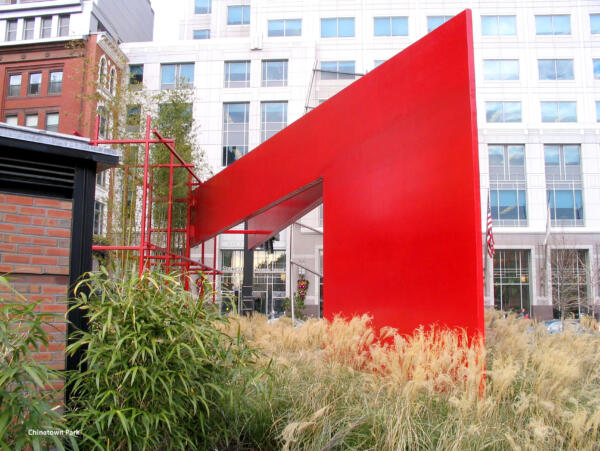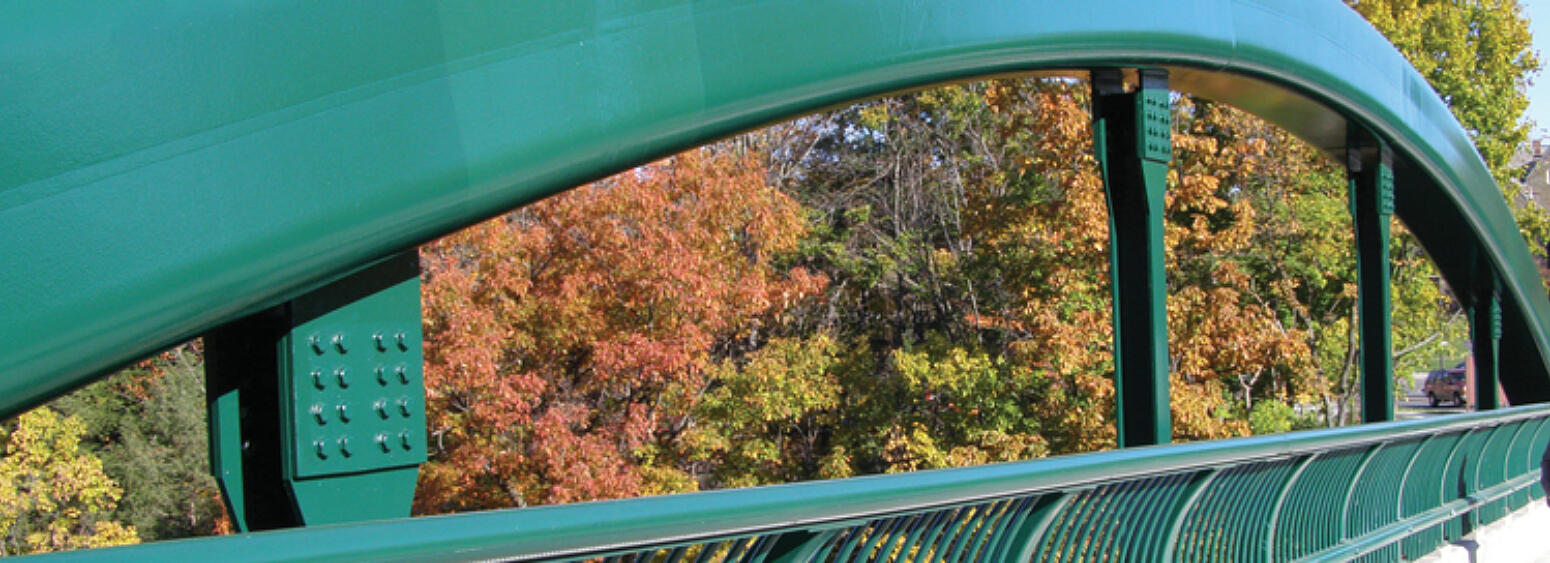Appearance
Aesthetics can be of high importance in the transportation industry. Whether it is an attractive, artfully designed bridge or airport terminal, or the visible appearance of airport jetways, stairwells, and baggage systems, galvanized steel allows design flexibility, the visual comfort of knowing steel is in good condition, and an attractive, natural gray finish.
The flexibility of steel lends it to great structural design. For instance, a hot-dip galvanized steel bridge allows for a range of design possibilities affecting both beauty and functionality. Unlimited by the weight and aesthetic constraints of concrete, steel bridges can take on a variety of appearances. Whether a truss, suspension, or cable-stayed structure, steel allows for flexible bridge design limited only by the engineer's imagination.
The same principal holds for the design of an airport terminal. Architecturally exposed structural steel elements can be arched and bent, and the use of steel permits the easy incorporation of glass and natural lighting into a space.
However, design is not the only concern. Passengers waiting to board their plane will be subconsciously comforted when they see the supporting elements such as jetway supports, baggage retrieval systems, and stairwells looking well-kept and in pristine condition.
Finally, hot-dip galvanized steel has a natural gray finish that can blend seamlessly with almost any setting. As the galvanized steel weathers and the zinc patina forms, the coating becomes a uniform matte gray. The non-intrusive finish is great for outdoor applications in rural, wildlife sensitive areas where pedestrian or small structural steel bridges may be constructed.
Appearance Case Study
Charlotte Douglas International Airport Parking Garage - Charlotte, NC; 2009
The Charlotte Douglas International Airport Parking Garage features a unique convex exterior façade reminiscent of the curvature of an airplane wing. With an average of 600 daily departures,CDIA is a rapidly growing airport in the southeastern United States.
As the passenger traffic has increased over the past few years, so has the demand for more parking. In late 2004, the airport began reconstruction to expand the 3,000-space parking facilitys capacity by 13 percent. In 2009, an additional garage at the site was specified to incorporate galvanized steel, due to the success of the 2004 structure.
The designer wanted to break away from the normal square, concrete box structure of parking facilities, and envisioned a facility that would mirror the curvature of an airplane wing. In order to accomplish this design, the architect and engineer decided to attach stainless steel cladding to a galvanized structural steel frame. Three hundred tons of hot-dip galvanized steel was used in the project including bow-string trusses, embed plates and anchors, stair towers, stairways, hand rails, and castellated beams. Galvanized steel was specified for its exceptional maintenance-free service life.
By specifying a hot-dip galvanized coating instead of a paint system, the garage will not require costly maintenance. Furthermore, the galvanized coating will allow the structure to remain a corrosion-free, attractive piece of the airport landscape well into the future.

Duplex Systems
If the matte gray finish doesn't suit your project, you can still get the great corrosion protection benefits and extended maintenance by utilizing a duplex system; galvanizing your project and then painting or powder coating over the galvanizing to the desired color. Duplex systems not only provide aesthetic options, but also extend the life of the project and the maintenance cycle of the paint or powder coating.
When hot-dip galvanized steel is painted or powder coated, the duplex system provides a more sophisticated manner of corrosion protection known as the synergistic effect. Used independently, both paint/powder coatings and galvanizing provide corrosion protection to steel; however, when utilized together, the two coatings work in synergy. The exterior layer of paint or powder coating slows down the rate at which the zinc is consumed, greatly extending the life of the galvanized steel. In return, once the exterior layer has been weathered down or damaged, the zinc beneath is still available to provide cathodic and barrier protection. As a result, the substrate steel is afforded corrosion protection for 1.5 to 2.3 times the sum of the expected life of each system alone.
Duplex systems are ideal for airport elements that require color-matching for branding or safety distinctions. Similarly, they are often utilized on bus and rail stations to help blend with the surrounding architecture, or along the line infrastructure to provide additional protection to extend the life of the structures. Many mass transit systems use color coding to designate different lines or directions, i.e. the green line, the blue line, and a duplex system means this is possible without sacrificing corrosion protection.
Unfortunately, a common problem throughout the transportation infrastructure is graffiti. Often these vandalizers want to leave their "mark" on the most public, visible structures and items such as bridges, sign structures, light posts, bus stops, and other transportation structures are targeted. Galvanized steel is easily cleaned, making it ideal for settings where this can be an issue.
Duplex Case Study
Thurston Avenue Bridge - Ithaca, NY; 2007

The Thurston Avenue Bridge is located on the campus of Ivy League school Cornell University in Ithaca, New York. The renowned school, visited from scholars around the world, is highly visible to the public. The bridge sits atop a treacherous gorge, and is passed over daily by students, and up to approximately 8500 vehicles, 950 pedestrians, and 60 bicycles per day. With the bridges appearance of utmost importance, the decision was made to apply hot-dip galvanizing to the steel rails atop the bridge and finish the top coat with a powder coated duplex system.
After completing a cost analysis that revealed utilizing hot-dip galvanizing (HDG) was equal or less expensive than a three-part paint system, HDG was an easy choice for the specifier. In addition to having great durability, hot-dip galvanizing was the perfect choice to maintain the look and feel of the design, as well as to protect the bridge from corrosive road salts used in the winter. With the quick turnaround time and quality of the duplex powder coat; the bridge will enjoy years of corrosion protection and serve as an example of how hot-dip galvanizing and the duplex system compliment each other to provide superior long-lasting maintenance free life.